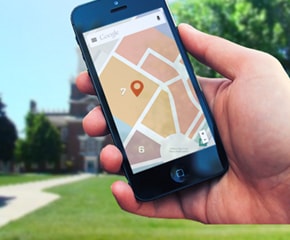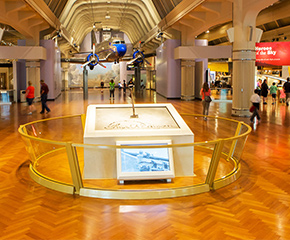
Actions of Innovation
Uncover: Broaden Perspectives
Grades 2-5
Science, English Language Arts, Social Studies
Driving Question
When working through the “Uncover” phase of an innovation journey, how can an innovator broaden his/her perspective to best understand the problem or need?Learning Objectives
Students will be able to:- Develop critical thinking skills to gain appreciation for a need/problem
- Build empathy to understand a need/problem
- Identify a problem’s source and substantiate their observations with facts
Why This Matters
Teaching students to be deliberate in their evaluation of information can guide them to becoming logical thinkers, as well as building empathy for a deeper understanding of a problem or need. To gain perspective, students must suspend judgement until evidence and facts are presented and supported by logic. Doing so will aid in a truer sense of a problem’s source(s). By using a historical photograph to teach observational techniques, including substantiating opinions with factual observations, students will build their critical thinking skills. The post-activity will help students learn that there is always more to learn about a situation.Standards
Common Core: CCSS.ELA-LITERACY.SL 2,3, 4,5.1; CCSS.ELA-LITERACY.SL 2,3, 4, 5.2; CCSS.ELA-LITERACY.SL 2, 3, 4,5.3; NGSS: K-2-ETS1-1;C3 Framework: D3.1; D3.2; D4.2; D4.4; D4.5.
Prep Activities
Students will analyze a historical image and make observation on what they see in the image and what they think is happening.
Core Activities
Formative Performance Task:
Students will engage in a discussion of what makes “good” information and how critical thinking, including the importance of logic and evidence, is necessary to support claims. Following the discussion, students will re-analyze a historical image.Follow-Up Activity
Students will write a question about something in the photograph that they want to learn more about, then conduct research to learn the information.Model i
Throughout this lesson, there will be opportunities to practice and develop Model I’s Habits of an Innovator and Actions of Innovation. Listed below are the Habits and Actions that students will be developing and practicing.Developing Habits of an Innovator
-
Stay Curious
Students will ask questions and wonder with their peers about a problem/need in a historical image. - Collaborate
Students will work together to understand a problem/need presented in a historical image. - Challenge the Rules
Students will challenge what they think they know as they discover new ideas from a historical image. - Be Empathetic
Students will walk in someone else’s shoes as they work to understand the underlying facts of a problem/need.
Practicing Actions of Innovation
- Uncover
Students will gain insight and a deeper understanding for a problem or need in a historic image. - Define
Students will use their new perspectives to name a specific problem or need.
Prep Activities
Find a historic photograph that is interesting to look at and tells a complex story that is not easily discernable, but relatable for students’ ages.If preferable, find a photograph that relates to and support classroom content. Search for your own historic photograph here.
Examples of possible photographs:
- Edison Institute Schools – Students Weaving, 1935
- Ford Model A Chassis Assembly Line, Ford Rouge Plant “B” Dearborn, MI, 1928
- Testing the Lunar Capsule Built by Ford Motor Company Aeronutronic Division, 1960
- John Borroughs and Henry Ford Sawing Down a Tree, Fort Myers, FL, 1914
Tell students that they are going to work on exercising their critical thinking brains to study a photograph. Do not give students any background on the photograph. Display the photograph.
Ask student to study the photograph, then answer the questions on paper. Encourage students to write as many details as they can in one minute.
- Who do they see in the photograph?
- What do they see happening in the photograph?
Be sure students understand there is no right/wrong answer. - Ask for volunteers to share.
As students share, push their thinking by asking probing questions, such as:
- What do you see that makes you say that?
- How do you know this is happening?
- What don’t you see?
- What do you wonder about?
Core Activities
Formative Performance Task:
Explain to students that what they were doing was using something called “critical thinking.” Questioning what we see and what we think about what we see are important life skills.Suggest a silly example to students that is easily relatable, for example: Your classmate told you the principal is outside giving ice-cream treats to anyone who sneaks out of class.
Use this silly story to discuss:
- Skepticism: Suspending judgement until we examine reasoning and factual evidence behind them. (Why might my classmate say the principal is outside giving away ice-cream? Does my classmate have anything to gain from me going outside when I’m not supposed to? Does my classmate have any evidence to support the claim?)
- Examining Assumptions: Assumptions are made when accepting something as true or untrue without proof. Everyone makes assumptions when they see or think about something. Assumptions can be helpful or hurtful. Give the students examples to help them understand.
- Challenging Reasoning: Using logic, a person evaluates arguments and reasoning, and strives to distinguish between good and bad reasoning. (Does it make sense that my principal is outside with ice-cream? Is it logical?)
- Uncovering Biases: We all have experiences that shape the way we see things. Where does bias come from? Culture? Upbringing? Experiences? (Do I have an experience that will help me decide if my principal is outside with ice-cream for kids who break the rules?)
What makes “good” information?
a. It needs to be guided by evidence that fits with reality—even if it refutes out beliefs or wishes. (I really wish my principal was outside giving ice-cream to kids who broke the rules, but he/she has never done that before and it doesn’t make sense. In addition, my classmate doesn’t have any evidence to support the story.
Now return to the historical photograph (or choose a new one if you’d like).
a. Begin again, this time as a group discussion—what is happening in this photograph.
b. Continue to challenge the students’ assumptions and comments, using the same questions from the Prep-Activity. Insist they back up their observations with facts or logic.
As students work through each part of the project, encourage them to reflect on how they are using or might use the Model i Habits and Actions to guide their project building.
Follow-Up Activity
Working with a partner, students will write a question about something they see in the photograph that they’d like to learn more about.If time permits, students can conduct research to learn this information and use it in the “Design” lesson.
Standards
Common Core State Standards In English Language Arts
CCSS.ELA-LITERACY.SL.2, 3, 4, 5.1. Engage effectively in a range of collaborative discussions with diverse partners on grade appropriate topics and texts, building on others’ ideas and expressing their own clearly.CCSS.ELA-LITERACY.SL.2, 3, 4,5.2. Determine (paraphrase or summarize) the main ideas and supporting details of a text read aloud or information presented in diverse media and formats, including visually, quantitatively, and orally.
CCSS.ELA-LITERACY.SL.2, 3, 4, 5.3. Ask and answer questions about information from a speaker, offering appropriate elaboration and details.
Next Generation Science Standards
K-2-ETS1-1. Ask questions, make observations, and gather information about a situation people want to change to define a simple problem that can be solved through the development of a new or improved object or tool.College, Career and Civic Life (C3) Framework for Social Studies State Standards
D3.1.K-2 and 3-5. Gather relevant information from multiple sources while using the origin, structure, and context to guide the selection.
D3.2.K-2 and 3-5. Use distinctions among fact and opinion to determine the credibility of multiple sources.
D4.3.3-5. Construct explanations using reasoning, correct sequence, examples and details with relevant information and data.
D4.4.K-2 and 3-5. Critique arguments.
D4.5.K-2 and 3-5. Critique explanations.


